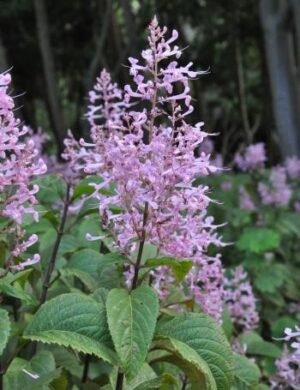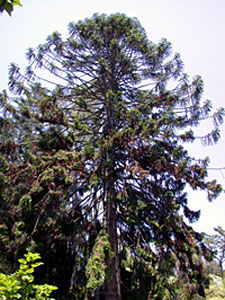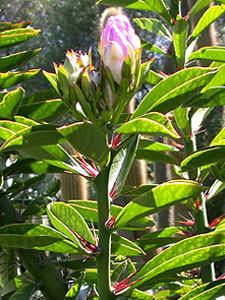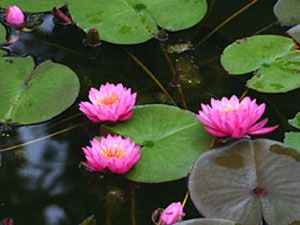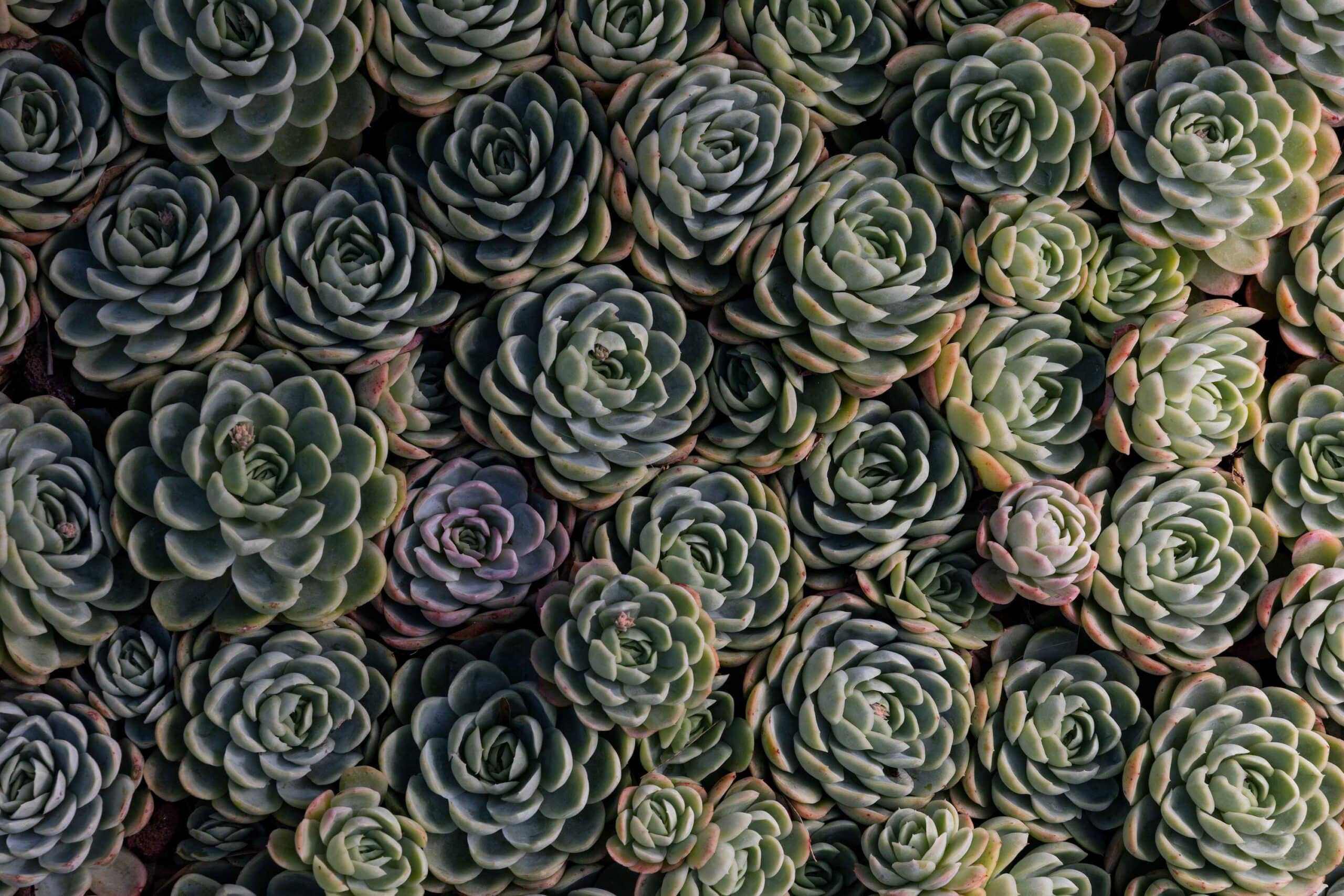
Plant Highlights
September
-
Alluaudia procera
Madagascar ocotillo
Highlight Month:
September
Nativity:
Southern Madagascar
Growth Habit:
Native to arid southern Madagascar, Alluaudia procera belongs in the Didiereaceae, a small family which is known for plants with thick, water storing stems. The Malagasy name for Alluaudia procera is “fantshiholitra” which means “the tree with the spiny bark.” The genus name honors Charles A. Alluaud, a French entomologist (1861-1949). The specific epithet, procera, comes from the Latin, procerus, which translates to “tall or slender,” an apt description for these plants with their long stems that curve upwards and back creating a wispy look from afar. In the wild, A. procera can reach up to 60 feet tall, but record heights in California are about 25 feet tall. In Madagascar, the large grouping of them in the southwest is known as an ecoregion called the spiny forest. Their stems are grey and are covered in spines, which are modified leaves, that can grow up to four inches long. A. procera leaves have two orientations; coming out horizontally on new growth and vertically on mature growth. The common name, Madagascar ocotillo, references this plant’s resemblance to the unrelated but superficially similar Fouquieria splendens of the Southwestern United States and northern Mexico.
Growing Requirements:
A. procera is hardy in USDA Zone 9a from about 20-25° F, growing best in full sun. It can do well in a container or dry garden due to its low water needs. This means it is best to let the soil fully dry before watering and to avoid letting the plant get oversaturated.
Features:
Alluaudia procera is dioecious having clusters of male or female flowers that are quite small and a white to greenish yellow color. This species is semi-deciduous, frequently losing some or all of its leaves in the cold season.
Where at Lotusland:
Succulent Garden
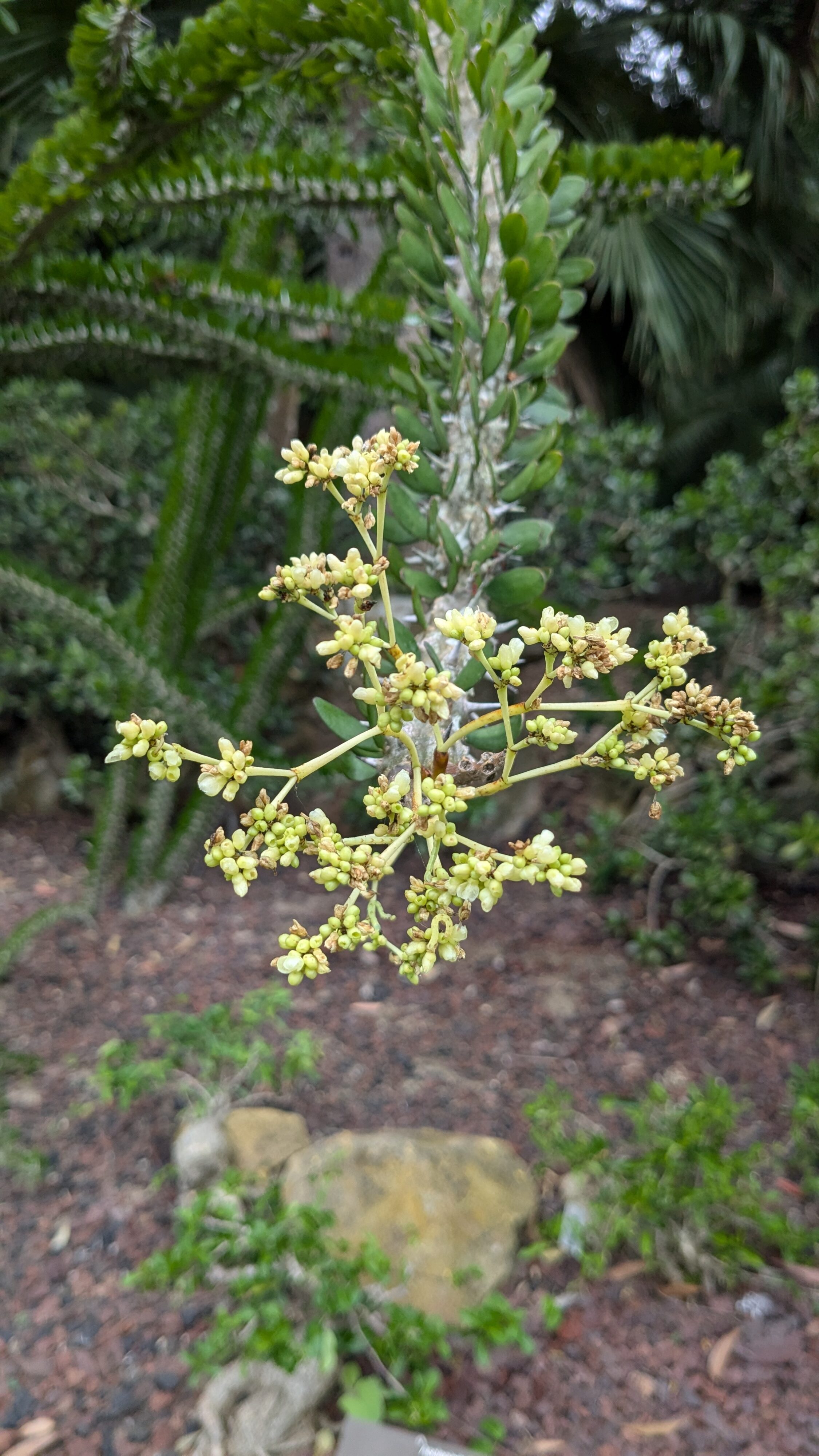
-
Ensete ventricosum
Abyssinian/Ethiopian banana, false banana
Highlight Month:
September
Nativity:
This large-scale banana is native to the eastern edge of the Great African Plateau.
Growth Habit:
E. ventricosum grows to 12-20’ in cultivation (30-40’ in habitat) and produces 10-12’ leaves that give a tropical look to the garden. Overlapping leaf petioles form a pseudo-trunk that expands at the base, hence the specific epithet, ventricosum, meaning “with a swelling belly.” This species rarely produces offsets from the base and will die after producing a dramatic inflorescence that takes over a year to develop. Small cream-colored flowers are hidden underneath maroon bracts with female/bisexual and male flowers occurring separately.
Growing Requirements:
This species is hardy to USDA Zones 10-11 but can be moved indoors for the winter in colder climates.
Features:
It is in the same family (Musaceae) as the more commonly cultivated banana but does not make palatable fruits. Instead, the heart of the plant is fermented to produce a variety of food products. The large black seeds are considered a famine food in Ethiopia and are also used to make beads.
Where at Lotusland:
Eight new plants of E. ventricosum were recently added to Lotusland’s Tropical Garden. All are seed propagations from a plant that flowered between August 2020-September 2021. The Water Garden is home to the red-leaved cultivar ‘Maurelii’, which is easier to find in cultivation than the straight species.
-
Microgramma vacciniifolia
Highlight Month:
September
Nativity:
M. vacciniifolia is native to moist/wet forests in tropical America (Venezuela and Columbia to Paraguay and Argentina) where it grows as an epiphyte (on other plants) or lithophyte (on rocks).
Growth Habit:
This fern displays attractive long rhizomes covered in brown scale-like hairs and dimorphic fronds. Fertile fronds are slender and develop sori (spore case clusters) on the underside whereas sterile fronds are round-ovate and do not play a direct role in reproduction.
Growing Requirements:
This fern performs well in hanging baskets, terrariums, and can be mounted to pieces of bark. In more arid climates, cultivation may be more successful in the ground where the humidity is higher. It can tolerate brief periods of 30-40°F but is considered tender to semi-tender.
Features:
The genus Microgramma is derived from the Greek mikros (small) and gramme (line), referring to the elongated sori of other members in the genus. Vacciniifolia references leaves in the shape of those in the genus Vaccinium (which includes blueberries, cranberries, and huckleberries).
Where at Lotusland:
This unusual and uncommon fern can be found in Lotusland’s Fern Garden growing in a hanging basket.
-
Plectranthus ecklonii ‘Erma’
Highlight Month:
September
Nativity:
Garden Origin
Growth Habit:
Plant this Plectranthus for showy pink flowers in the fall! This species is native to eastern South Africa and is usually found along forest margins and streambanks.
Growing Requirements:
‘Erma’ is best grown in partial shade and has pink flowers, unlike the usual purple of the straight species. Prune it back hard in the winter to maintain a small size, otherwise the plant will reach over 10’ tall.
Features:
The cultivar ‘Erma’ is named after the wife of legendary South African plantsman, Ernst van Jaarsveld, who specializes in Lamiaceae and even has a compact caudiciform Plectranthus named in his honor (P. ernstii). Our plants originally came from Kirstenbosch National Botanical Garden in Cape Town, South Africa.
Where at Lotusland:
Lotusland has plantings of Plectranthus ecklonii ‘Erma’ in the Cycad Garden (near the entrance to the Tropical Garden) and Insectary Garden.
-
Agave atrovirens
pulque agave, maguey
Highlight Month:
September
Nativity:
Mexico (Oaxaca, Puebla, and Veracruz)
Growth Habit:
This is the largest of all Agave species and can reach 6-8’ tall with a spread of 8-12’. When mature, the plant will flower and eventually die, but not before producing a 15’ asparagus-like inflorescence with bright yellow flowers.
Growing Requirements:
Sun, well-drained soils. Drought tolerant.
Features:
A. atrovirens it is one of the agaves fermented in the production of pulque and mezcal. The specific epithet, atrovirens, references its dark green leaves (from the Latin ‘ater’= black/dark and ‘virens’= green).
Where at Lotusland:
Dunlap Garden
-
Rosmarinus officinalis ‘Lockwood de Forest’
Lockwood de Forest rosemary
Highlight Month:
September
Nativity:
Garden Origin
Growth Habit:
This prostrate cultivar of rosemary was discovered as a seeding in the Santa Barbara garden of Lockwood and Elizabeth de Forest. This rosemary grows only 2 feet tall, but its low-growing branches can reach a length of 6 to 8 feet, making it a great choice as either a groundcover or a cascading accent over a rock wall.
Growing Requirements:
Full sun, well-draining soil.
Features:
Madame Ganna Walska consulted with Lockwood de Forest to design the orchard, succulent garden, and main house cacti plantings at Lotusland. Blue flowers emerge in the spring, fall, and winter and resemble “the color of the old French air force uniform,” according in Elizabeth de Forest.
Where at Lotusland:
In pots on the Parterre.
-
Iochroma coccinea and Iochroma cyaneum
Highlight Month:
September
Nativity:
There are around 20 species of Iochroma, native to Central and South America.
Growth Habit:
The two species of Iochroma growing at Lotusland are shrubby perennials 8-10 feet tall. They can be trained as a small tree or pruned into a rounder shrub form. The flowers are borne on the new growth, so prune stems back at the end of the blooming season to promote next year’s flower production.
Growing Requirements:
Plant in full sun to partial shade. Iochroma are not drought-tolerant and require regular watering during the summer months.
Features:
Iochroma have 3 inch long tubular flowers that hang down from the branches. They flower from spring through fall, or sometimes year round in warm-winter areas.
Where at Lotusland:
There are both red-flowered (Iochroma coccinea) and blue-flowered (Iochroma cyaneum) species growing in the Fern Garden.
-
Araucaria bidwillii
bunya-bunya, bunya pine
Highlight Month:
September
Nativity:
Queensland, Australia
Growth Habit:
An evergreen coniferous tree which can reach up to 100 feet tall. Younger trees have a distinctive conical shape, which becomes rounded with age as the lower branches drop. They make beautiful shade trees with enough space, though the large cones and fallen spiny dried branchlets make them hazardous in areas with pedestrians. At Lotusland, the cones are removed by arborists every year to ensure no one is injured below.
Growing Requirements:
Grows in full sun to partial shade; needs regular watering. Young plants make good container specimens outdoors and also indoors, as they are able to grow well in low light.
Features:
Bunya-bunya have two types of foliage. The younger or understory needles are narrow, glossy green with a point and are arranged in two rows. Mature leaves are stiff with very sharp points and spirally arranged around the branchlets. A. bidwillii produces very large, spiny female cones up to 2 feet long and 1 foot wide, weighing 10 – 15 pounds. The cones take two years to mature, and each contains up to a hundred seeds. The large seeds are a food source for aboriginal Australian peoples.
Where at Lotusland:
There are five A. bidwillii at Lotusland growing in the Japanese Garden and the Blue Garden.
-
Pereskia grandifolia
rose cactus
Highlight Month:
September
Nativity:
Native to Brazil and commonly found north through Mexico.
Growth Habit:
A sprawling shrub growing 15 ft tall. Deciduous in cool winter climates. It is easily propagated from cuttings or seeds.
Growing Requirements:
Grows in full sun or partial shade. It needs well-drained soil but more water than most cacti, especially during the summer growing season.
Features:
Pereskia is a genus in the cactus family that is unusual in having large leaves as well as spines. P. grandifolia has pink or white rose-like flowers which are followed by pear-shaped green fruit.
Where at Lotusland:
The rose cactus grows in the Cactus Garden, along with several other types of Pereskia.
-
Nymphaea species
waterlily
Highlight Month:
September
Nativity:
Garden Origin
Growth Habit:
Hardy and tropical waterlilies grow in lakes and ponds in shallow water from 2 to 6 feet deep. Hardy types go dormant and remain in the pond year round. Tropical varieties are mostly treated as annuals outside the tropics, although they may be over-wintered in a warm tank.
Growing Requirements:
Waterlilies are rooted in the mud in nature, so they require planters or pots in a water garden. Use good soil without organic amendments and plant in full sun.
Features:
Waterlilies provide a nearly unlimited spectrum of colorful flowers in the water garden. Hardy varieties occur in white, pink, red, yellow and shades of orange. Tropicals are more electric and include the above colors as well as blue and purple. There are some tropical varieties that bloom at night, opening in late afternoon and closing by mid-morning. All others bloom during the day.
Where at Lotusland:
In the Water Garden ponds adjacent to the original swimming pool (now the lotus pond) and in the Japanese Garden pond.




